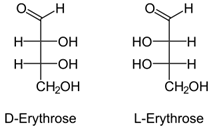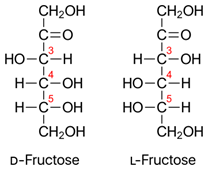
Bundle: Introduction to General, Organic and Biochemistry, 11th + OWLv2, 4 terms (24 months) Printed Access Card
11th Edition
ISBN: 9781305705159
Author: Frederick A. Bettelheim, William H. Brown, Mary K. Campbell, Shawn O. Farrell, Omar Torres
Publisher: Cengage Learning
expand_more
expand_more
format_list_bulleted
Concept explainers
Question
Chapter 20, Problem 20.15P
Interpretation Introduction
Interpretation:
To identify D-monosaccharides, and L-monosaccharides in the given molecules.
Concept Introduction:
In a monosaccharide, if at the last stereocenter the hydroxyl group is at right in the Fischer projection, the monosaccharide is known to have D configuration. Opposite to it if the hydroxyl group is at left, the monosaccharide will have L configuration. Some examples of D and L monosaccharides are as follows:


Expert Solution & Answer
Want to see the full answer?
Check out a sample textbook solution
Students have asked these similar questions
Don't use ai to answer I will report you answer
Consider a solution of 0.00304 moles of 4-nitrobenzoic acid (pKa = 3.442) dissolved in 25 mL water and titrated with 0.0991 M NaOH. Calculate the pH at the equivalence point
What is the name of the following compound?
SiMe3
Chapter 20 Solutions
Bundle: Introduction to General, Organic and Biochemistry, 11th + OWLv2, 4 terms (24 months) Printed Access Card
Ch. 20.1 - Prob. 20.1PCh. 20.2 - Prob. 20.2PCh. 20.2 - Prob. 20.3PCh. 20.3 - Prob. 20.4PCh. 20.4 - Prob. 20.5PCh. 20 - Prob. 20.6PCh. 20 - Prob. 20.7PCh. 20 - Prob. 20.8PCh. 20 - Prob. 20.9PCh. 20 - Prob. 20.10P
Ch. 20 - Prob. 20.11PCh. 20 - Prob. 20.12PCh. 20 - Prob. 20.13PCh. 20 - Prob. 20.14PCh. 20 - Prob. 20.15PCh. 20 - Prob. 20.16PCh. 20 - Prob. 20.17PCh. 20 - Prob. 20.18PCh. 20 - .19 What is an amino sugar? Name the three amino...Ch. 20 - Prob. 20.20PCh. 20 - Prob. 20.21PCh. 20 - Prob. 20.22PCh. 20 - Prob. 20.23PCh. 20 - Prob. 20.24PCh. 20 - Prob. 20.25PCh. 20 - Prob. 20.26PCh. 20 - Prob. 20.27PCh. 20 - Prob. 20.28PCh. 20 - Prob. 20.29PCh. 20 - Prob. 20.30PCh. 20 - Prob. 20.31PCh. 20 - Prob. 20.32PCh. 20 - Prob. 20.33PCh. 20 - Prob. 20.34PCh. 20 - Prob. 20.35PCh. 20 - Prob. 20.36PCh. 20 - Prob. 20.37PCh. 20 - Prob. 20.38PCh. 20 - Prob. 20.39PCh. 20 - Prob. 20.40PCh. 20 - Prob. 20.41PCh. 20 - Prob. 20.42PCh. 20 - Prob. 20.43PCh. 20 - Prob. 20.44PCh. 20 - Prob. 20.45PCh. 20 - 6 Where is glycogen stored in the human body?Ch. 20 - Prob. 20.47PCh. 20 - 8 How is it possible that cows can digest grass...Ch. 20 - Prob. 20.49PCh. 20 - Prob. 20.50PCh. 20 - 1 Hyaluronic acid acts as a lubricant in the...Ch. 20 - 2 The anticlotting property of heparin is partly...Ch. 20 - Prob. 20.53PCh. 20 - Prob. 20.54PCh. 20 - Prob. 20.55PCh. 20 - Prob. 20.56PCh. 20 - Prob. 20.57PCh. 20 - Prob. 20.58PCh. 20 - Prob. 20.59PCh. 20 - Prob. 20.60PCh. 20 - Prob. 20.61PCh. 20 - 2 In making candy or sugar syrups, sucrose is...Ch. 20 - Prob. 20.63PCh. 20 - Prob. 20.64PCh. 20 - Prob. 20.65PCh. 20 - Prob. 20.66PCh. 20 - Prob. 20.67PCh. 20 - Prob. 20.68PCh. 20 - Prob. 20.69PCh. 20 - 0 What are the structural differences between...Ch. 20 - Prob. 20.71PCh. 20 - Prob. 20.72PCh. 20 - Prob. 20.73PCh. 20 - Prob. 20.74PCh. 20 - Prob. 20.75PCh. 20 - Prob. 20.76PCh. 20 - Prob. 20.77PCh. 20 - Prob. 20.78PCh. 20 - Prob. 20.79PCh. 20 - Prob. 20.80PCh. 20 - Prob. 20.81PCh. 20 - Prob. 20.82PCh. 20 - Prob. 20.83PCh. 20 - Prob. 20.84PCh. 20 - Prob. 20.85PCh. 20 - Prob. 20.86PCh. 20 - Prob. 20.87PCh. 20 - Prob. 20.88PCh. 20 - Prob. 20.89P
Knowledge Booster
Learn more about
Need a deep-dive on the concept behind this application? Look no further. Learn more about this topic, chemistry and related others by exploring similar questions and additional content below.Similar questions
- K Draw the starting structure that would lead to the major product shown under the provided conditions. Drawing 1. NaNH2 2. PhCH2Br 4 57°F Sunny Q Searcharrow_forward7 Draw the starting alkyl bromide that would produce this alkyne under these conditions. F Drawing 1. NaNH2, A 2. H3O+ £ 4 Temps to rise Tomorrow Q Search H2arrow_forward7 Comment on the general features of the predicted (extremely simplified) ¹H- NMR spectrum of lycopene that is provided below. 00 6 57 PPM 3 2 1 0arrow_forward
arrow_back_ios
SEE MORE QUESTIONS
arrow_forward_ios
Recommended textbooks for you
 ChemistryChemistryISBN:9781305957404Author:Steven S. Zumdahl, Susan A. Zumdahl, Donald J. DeCostePublisher:Cengage Learning
ChemistryChemistryISBN:9781305957404Author:Steven S. Zumdahl, Susan A. Zumdahl, Donald J. DeCostePublisher:Cengage Learning Chemistry: An Atoms First ApproachChemistryISBN:9781305079243Author:Steven S. Zumdahl, Susan A. ZumdahlPublisher:Cengage Learning
Chemistry: An Atoms First ApproachChemistryISBN:9781305079243Author:Steven S. Zumdahl, Susan A. ZumdahlPublisher:Cengage Learning
 Organic ChemistryChemistryISBN:9781305580350Author:William H. Brown, Brent L. Iverson, Eric Anslyn, Christopher S. FootePublisher:Cengage LearningChemistry: Matter and ChangeChemistryISBN:9780078746376Author:Dinah Zike, Laurel Dingrando, Nicholas Hainen, Cheryl WistromPublisher:Glencoe/McGraw-Hill School Pub Co
Organic ChemistryChemistryISBN:9781305580350Author:William H. Brown, Brent L. Iverson, Eric Anslyn, Christopher S. FootePublisher:Cengage LearningChemistry: Matter and ChangeChemistryISBN:9780078746376Author:Dinah Zike, Laurel Dingrando, Nicholas Hainen, Cheryl WistromPublisher:Glencoe/McGraw-Hill School Pub Co Introduction to General, Organic and BiochemistryChemistryISBN:9781285869759Author:Frederick A. Bettelheim, William H. Brown, Mary K. Campbell, Shawn O. Farrell, Omar TorresPublisher:Cengage Learning
Introduction to General, Organic and BiochemistryChemistryISBN:9781285869759Author:Frederick A. Bettelheim, William H. Brown, Mary K. Campbell, Shawn O. Farrell, Omar TorresPublisher:Cengage Learning

Chemistry
Chemistry
ISBN:9781305957404
Author:Steven S. Zumdahl, Susan A. Zumdahl, Donald J. DeCoste
Publisher:Cengage Learning

Chemistry: An Atoms First Approach
Chemistry
ISBN:9781305079243
Author:Steven S. Zumdahl, Susan A. Zumdahl
Publisher:Cengage Learning


Organic Chemistry
Chemistry
ISBN:9781305580350
Author:William H. Brown, Brent L. Iverson, Eric Anslyn, Christopher S. Foote
Publisher:Cengage Learning

Chemistry: Matter and Change
Chemistry
ISBN:9780078746376
Author:Dinah Zike, Laurel Dingrando, Nicholas Hainen, Cheryl Wistrom
Publisher:Glencoe/McGraw-Hill School Pub Co

Introduction to General, Organic and Biochemistry
Chemistry
ISBN:9781285869759
Author:Frederick A. Bettelheim, William H. Brown, Mary K. Campbell, Shawn O. Farrell, Omar Torres
Publisher:Cengage Learning